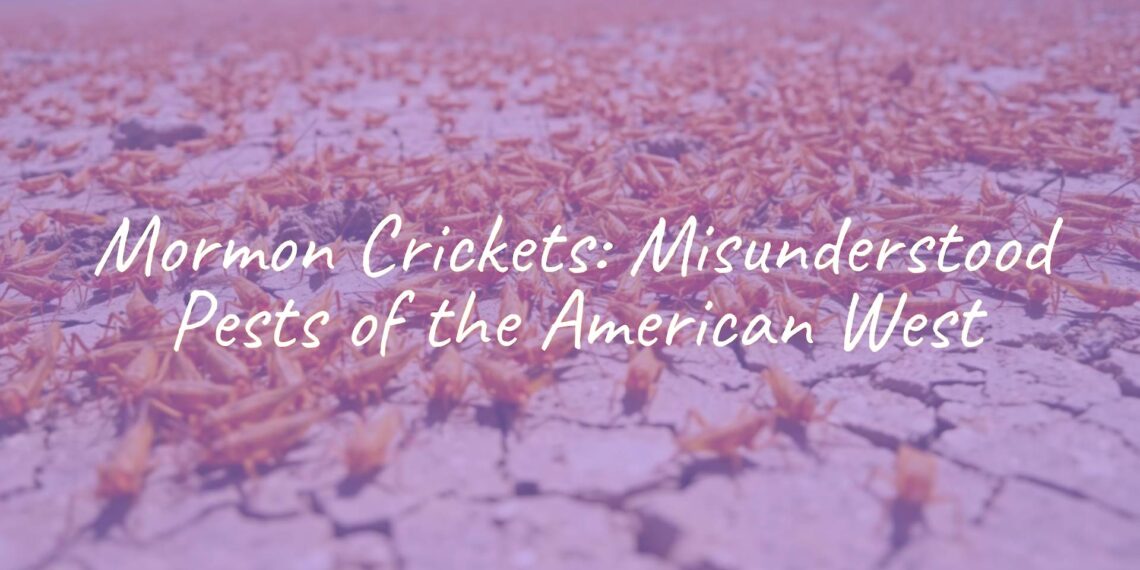Mormon crickets are large, flightless insects found in western North America. Despite their name, they are not true crickets, but rather belong to the katydid family (Tettigoniidae). The species’ scientific name is Anabrus simplex. These insects are best known for forming massive swarms that can cause major problems for farms, roads, and local environments. Mormon crickets got their common name from an event in 1848, when Mormon settlers in Utah faced crop destruction from these insects, leading to the “Miracle of the Gulls” story. Although they look like chunky grasshoppers, their habits and life cycle are distinct, bringing both scientific curiosity and concern when outbreaks happen.

What Are Mormon Crickets?
Mormon crickets, or Anabrus simplex, catch attention for both their misleading name and their large group movements. It’s important to note from the beginning that they are not part of the regular cricket family (Gryllidae), but are classified as katydids. In other words, they are shield-backed katydids, and not related to the chirping crickets familiar to many people.
Here is how these insects are classified:
| Rank | Classification |
|---|---|
| Domain | Eukaryota |
| Kingdom | Animalia |
| Phylum | Arthropoda |
| Class | Insecta |
| Order | Orthoptera |
| Suborder | Ensifera |
| Family | Tettigoniidae |
| Genus | Anabrus |
| Species | Anabrus simplex |
The name Anabrus simplex was given by Haldeman in 1852 and helps put this insect in its proper group within the large set of insects. This classification also clears up confusion around their common name.
How to Recognize a Mormon Cricket
- Size: Can reach up to 8 cm (3 inches) in length
- Color: Range from black, brown, and red to purple or green. Color often depends on whether they are alone or in swarms.
- Solitary phase: Usually green or purple, which helps them blend into plants
- Swarming phase: Usually darker colors, like black, brown, or red-this shift is caused by crowded conditions
- Pronotum (shield on their back) covers small, non-working wings-they cannot fly
- Females have a long egg-laying tube (ovipositor) which may look like a stinger but is harmless
- Long, thread-like antennae, often longer than the body

Taxonomy
While people call them “crickets,” Mormon crickets are not “true” crickets. They belong to the katydid group in the Tettigoniidae family. Their long antennae separate them from other similar insects. Despite their large group events, NatureServe labels them as “Secure”, meaning their overall population is not under threat. Knowing their exact place in the insect world helps manage them and corrects misunderstandings.
Where Do Mormon Crickets Live?
These insects are most often found in the states of the American West, including the Great Basin and Intermountain West. Their wide range covers much of western North America, where they become well-known nuisances during population spikes.
- East to West: Dakotas, Nebraska, Kansas, to the mountains of Washington, Oregon, Northern California
- North: Southeastern British Columbia, Southern Alberta, Saskatchewan, Manitoba (Canada)
- South: Northern Arizona and New Mexico
- Montana alone: found in 33 counties
Most live in open sagebrush and grasslands, sometimes at very high elevations (up to 11,000 feet), showing they can survive in many conditions.

Preferred Habitat
They mainly like rangelands covered with sagebrush and forbs (non-grassy flowering plants). These give them both food and soil to lay eggs. Sometimes they live in forest openings, but in smaller groups. Outbreaks may focus in certain states, like Nevada-where millions of acres can be affected. For example, in 2006, 10 million acres in Nevada were infested.
Seasonal and Migratory Behavior
One of the most noticeable things about Mormon crickets is their habit of moving in large bands. Even though they can’t fly, they walk and hop, covering up to 2 km (about 1.25 miles) a day and sometimes 25 to 50 miles in a season.
- Usually move in one direction, in the daytime, at temperatures between 65°F and 95°F
- They hide under plants and stop moving if it’s too hot or cold, or at night unless nights are warm
- Bands form for two main reasons: searching for food (protein, salt) and to prevent being eaten by other crickets behind them
- Bands may combine and form huge fronts-over a mile wide and up to ten miles deep
Mormon Cricket Life Cycle
Understanding their life cycle is important for knowing why their numbers can sometimes get out of control.
- Females lay more than 100 eggs each, placing them deep in the soil using their ovipositor
- Eggs stay dormant through winter and hatch in spring when the ground is about 4°C (40°F)
- At higher elevations, eggs may wait several years before hatching
Development Stages
- Nymph: Small and black with a white stripe after hatching, about ¼ inch long
- Instars: Pass through 7 stages, growing and sometimes changing color-common shades are black, brown, orange, green
- Molting: Shed their skin several times before becoming adults, often eating their old skin for nutrients
- Adults: Within two weeks of becoming adults, they breed. Males provide a large spermatophore, which is both a food source for females and contains sperm.
After mating, the cycle repeats as females lay large numbers of eggs.

Why Do Mormon Crickets Have Sudden Population Surges?
Most years, numbers are low. But sometimes, huge outbreaks happen. Swarms can contain millions of crickets, with up to 100 per square meter.
- Drought is the most common driver of outbreaks. Recent surges in places like Nevada (since 2019) are tied to dry conditions.
- Outbreaks can last for a few years up to two decades before naturally declining.
What Do Mormon Crickets Eat?
Mormon crickets eat a huge variety of food, contributing to the damage they cause in swarms. They are not picky and will even eat other crickets if necessary.
Food Preferences
- Prefer forbs like milkvetches, penstemons, dandelion, wild mustard, pepperweed
- Also eat grasses, shrubs (including sagebrush and saltbush), and over 400 different plant species
- Eat seeds and sometimes focus on just a few plants if those are all that’s available
They will eat other insects, dead animals, fresh manure, and are well-known for cannibalism. They often eat injured or dead crickets found on roads or after pesticide treatments to get extra nutrients.
Crop and Environmental Impact
- Attack field crops like wheat, barley, alfalfa, sweetclover, vegetables, and home gardens
- One cricket per square yard can eat about 38 pounds of dry plants per acre through its youth-so millions can cause major loss
- Hay contaminated with crushed crickets becomes unusable for livestock
- Heavy infestations can lead to soil erosion and poor water quality, harming the land beyond just eating crops
Damages in past years have sometimes cost states hundreds of thousands in lost crops.

Why Do Mormon Crickets Swarm?
Swarming is the behavior people most associate with Mormon crickets. These are not random gatherings, but a response to hunger and to avoid being eaten by other crickets.
Reasons for Swarming
- Looking for essential food: protein and salt. At high density, food runs low fast
- Moving forward to avoid being eaten by other hungry crickets coming from behind (cannibalism is common in swarms)
Size of Swarms
- Bands of millions, up to 100 crickets per square meter
- Travel up to 2 km per day, 25-50 miles per season
- Swarm fronts can be more than a mile wide and up to ten miles deep
Threats to Crops and People
- Destroy large fields quickly, affecting farm livelihoods
- Dead and squashed crickets make roads slick, leading to accidents. AAA recommends driving slowly, avoiding sharp driving moves in affected areas.
- May need snowplows or leaf blowers to clear crickets from properties and roads
- Dead crickets can stain buildings and sidewalks; millions of crickets can also be unsettling and stressful for people living nearby
History of Mormon Crickets
Mormon crickets have affected the western United States for centuries, shaping both the land and local stories. Famous outbreaks are described in old diaries, such as an 1846 Oregon Trail entry mentioning miles of ground covered with crickets eating each other when crushed.
Key Outbreaks
- 1840s: In Salt Lake Valley, destroyed crops that Mormon settlers relied on; the reason for their current name
- 1937: Montana suffered over $500,000 in losses from one outbreak; Wyoming lost $383,000
- 2003: Known as one of the worst modern outbreaks in Utah, Idaho, and Nevada
- 2019-present: Active outbreaks in Nevada and other areas; some surges can last up to 20 years.
The “Miracle of the Gulls”
One of the most memorable stories is from the late 1840s. Settlers facing starvation due to crickets saw flocks of California gulls arrive and eat the insects. This was seen as a miracle that saved their crops, and it made the gull the state bird of Utah. Today, it still shapes local culture, even though the gulls were just doing what they naturally do: hunting insects near their breeding grounds.

How Are Mormon Crickets Managed?
Dealing with Mormon crickets takes several approaches, combining chemical, physical, and natural methods. Because swarms are big and move quickly, a mix of solutions is needed.
| Method | How It Works |
|---|---|
| Carbaryl bait (“Sevin Dust”) | Kills crickets directly; also poisons those that eat dead crickets |
| Dimilin (growth regulator) | Prevents young crickets from growing into adults |
| Physical barriers | Fences (2ft high, smooth surface) can keep crickets away from homes/gardens |
| Biopesticides | Fungus-based products (like Nosema locustae) disrupt cricket digestion and kill them |
| Natural predators | Gulls, crows, coyotes, small mammals, certain wasps, and parasitic worms/flies eat or infect crickets |
For small numbers indoors, vacuum crickets and throw away the bag. In fall, disturb lawns or gardens to expose eggs to freezing and drying out. Predators and parasites also help control numbers naturally.
Pesticide Use and Safety
- The USDA often uses aerial spraying in stripe patterns for big outbreaks
- Some worry about drifting pesticides harming bees and other helpful insects, as well as water life. A recent Oregon court decision pushed for safer practices and more care for the environment.
- Diatomaceous earth products (like PERMA-GUARD) are a safer option. These work physically, not chemically, by dehydrating insects.
- Before using any pesticide, consider the stage of the cricket, what else is in the environment, and product safety labels.
Government and Landowners
- State and federal agencies monitor outbreaks and may treat areas if densities rise (over 2 crickets per square yard)
- Most places can only be sprayed once per season to protect the environment
- People are encouraged to report sightings to local/state agriculture departments for better management and response planning
Tips for Property Owners in Cricket Areas
For those living in outbreak areas, Mormon crickets can feel like an impossible problem. But good planning can reduce damage.
When to Get Help
- Contact your agricultural extension office or state agriculture department for large infestations-especially if you can’t control them with barriers or store-bought baits
- Professionals can advise on large-area controls, and safe use of stronger pesticides
- If crickets threaten crops or make surfaces unsafe (slick driveways, for example), consult pest specialists who can handle extensive problems
Steps to Protect Your Property
- Put up smooth fences at least 18-24 inches high around plants and gardens
- In fall, till gardens and rake lawns to bring eggs to the surface so they die over winter
- Use diatomaceous earth powder as a physical barrier-it works by drying out the insects
- Monitor for early signs of crickets; keep up-to-date with forecasts from agricultural agencies
Common Questions about Mormon Crickets
Are They Dangerous to Humans or Pets?
Generally, no. Mormon crickets do not bite, sting, or carry diseases harmful to people or pets. The egg-laying tube on females looks like a stinger but is harmless. Pets might try to eat them, but it is unlikely to cause harm-although eating many may cause a mild stomach upset. The main threat is indirect, caused by slick road conditions from crushed insects, which can lead to vehicle accidents.
Do Mormon Crickets Fly?
No-they have small, nonfunctional wings and cannot fly. Instead, they crawl or hop, which is why barriers are effective against them.
What Attracts Mormon Crickets?
They are drawn to areas with lots of the plants they like to eat, as well as places with good soil for egg-laying. During droughts, outbreaks can worsen as competition for food increases. Their search for protein and salt can also push them into gardens, fields, or even neighborhoods-especially when their population is booming.
















![What to with Scrap Metal? [infographic]?](https://facts-homes.com/wp-content/uploads/2019/07/645413-POPYOV-391-120x86.jpg)





